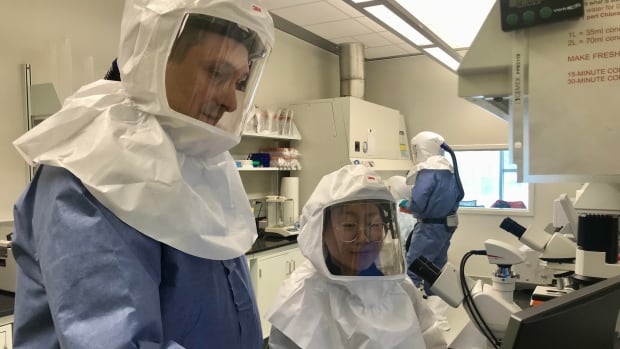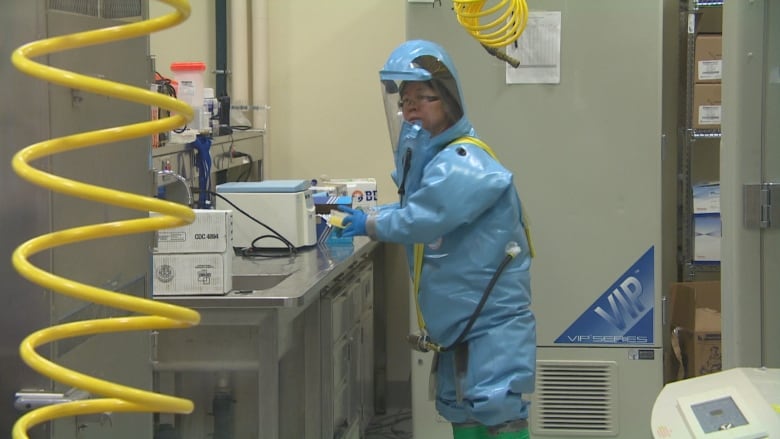
Canada will soon have a second laboratory capable of working with the most dangerous pathogens in the world — home to Canada’s Centre for Pandemic Research.
It will be the only non-government Level 4 facility in the country, part of the University of Saskatchewan’s Vaccine and Infectious Disease Organization (VIDO), which currently has a Level 3 lab.
“It’s all about being ready for the next disease, right? I think the pandemic has shown us that Canada largely depended on other countries to do the critical research, but also develop vaccines,” said Volker Gerdts, director and CEO of VIDO.
“By upgrading to the highest level, to Level 4, we’re able to in the future work with any pathogen, whether it’s a human or an animal pathogen.”
The renovations should be finished next year. The centre already includes a bio-manufacturing facility and will build housing for exotic species, including bats, which are used in research.
The new Level 4 lab at the University of Saskatchewan, which will contain the new Canadian Centre for Pandemic Research, is being developed as the federal government is working to improve biosafety and biosecurity measures for high-containment labs — and in the wake of security criticisms at Canada’s existing Level 4 lab in Winnipeg.
The upgrade comes as the federal government is updating the Human Pathogens and Toxins Act to improve biosafety and biosecurity measures for high-containment labs — and as the Public Health Agency of Canada (PHAC)’s Level 4 lab in Winnipeg has been criticized for lax security in a case involving two scientists originally from China.
In July 2019, Xiangguo Qiu, her husband Keding Cheng and their students were escorted out of the National Microbiology Laboratory (NML) and stripped of their security clearances. They were fired in January 2021, triggering concerns about Chinese espionage.
An assessment by the Canadian Security Intelligence Service (CSIS) found that Qiu had “intentionally” shared scientific information with China.
VIDO has been working “closely” with CSIS for years, and while it boasts scientists from 30 countries, Gerdts said it is not collaborating with researchers in Russia and China, two countries with military and state agencies considered the highest risk to national security.
Gerdts declined to comment on the scandal. He said VIDO follows the federal government’s new research security guidelines.
“I’m not really concerned about any security breaches,” he said. “We have an impeccable safety record. We have not had any problems so far.
“In fact, I would say we’re — at the moment, at least — the leading facility when it comes to biosafety in Canada.”
Collaboration, not competition
Some of the top scientists who have led the special pathogens program at the NML — and are now working in the United States — say a second Level 4 lab is good news for Canadians.
“I’m sure a lot of positive will come out of that,” said Gary Kobinger, who worked at the NML from 2008 to 2016. He now runs the Level 4 Galveston National Laboratory at the University of Texas.
Kobinger believes there is room for two labs in Canada, especially if they have different mandates. The NML focuses on basic science, identifying outbreaks and developing diagnostic tests, while VIDO does applied research, including producing vaccines and therapeutics.
By necessity, they will need to co-operate and not compete, he said.
VIDO’s biggest strength is that it’s not government-owned, Kobinger said, giving it more flexibility. The NML’s special pathogens unit is “completely paralyzed right now” by policies and regulations — and he said red tape can stifle research and collaboration.

Heinz Feldmann also said non-government labs have different opportunities than government institutions, which “are often limited in their interaction with industrial partners and grant funding agencies.”
“The downside could be sustainability,” said Feldmann, who ran the NML’s special pathogens program from the time it opened in 1999 until 2008, when he became chief of virology of the National Institute of Allergy and Infectious Diseases’ Rocky Mountain Laboratories in Montana.
He said a government-funded budget may be more stable, but other academic labs have shown they can get funding through grants, industry collaborations and contracts.
Increase in high-security labs raises concerns
The number of labs studying the deadliest known pathogens has increased dramatically since SARS-CoV-2, the virus that causes COVID-19, was first identified in 2019.
There were 51 operating Level 4 labs in 27 countries as of last year, roughly double the number 10 years ago, according to the Global BioLabs Report. Another 18, including Saskatchewan’s, are planned or under construction.
The biggest growth areas are in Asia and Africa, said Filippa Lentzos, a biosecurity expert who leads the Global BioLabs mapping project at King’s College London, which will publish its next report in 2025.
And while the labs themselves are not dangerous, as more countries do research with deadly pathogens, there are growing risks “that you might become infected, that you might infect others, and including the environment and people around you.”
There are also increased security concerns: “Who has access to the lab, who gets access to biological agents?”

Canada’s standards are some of the most stringent in the world, Lentzos said. She has not heard any concerns about the NML’s security in the wake of the CSIS documents released in February. In fact, she says the system worked.
“I don’t think the reputation of the lab has been dented in that sense. I think it’s actually been more of a wake-up call for other labs around the world, to say what we do in our labs is of interest to other governments.”
Improving safety and security
PHAC said screening measures are being strictly enforced at the National Microbiology Lab for all staff and external visitors.
Ottawa is doing even more consultations on how to improve biosafety and biosecurity measures for non-government facilities.

The public health agency has been consulting Canadians to gain a better understanding of what changes and improvements could be made to the Human Pathogens and Toxins Act.
It conducted an online questionnaire last fall to identify areas of interest regarding the amendments. Those surveyed included consumer organizations, regulated facilities and lower levels of government.
The top areas of interest were access controls to the containment zone, cyber and information security and physical on-premises security, according to a report published online.
Respondents said they were concerned that any new regulatory requirements would cause administrative burden and delays, and would negatively impact future research and investment in Canada.
In a statement, PHAC said changes to regulation will aim to respond to “evolving biosecurity threats” as Canada expands its bio-manufacturing sector.


